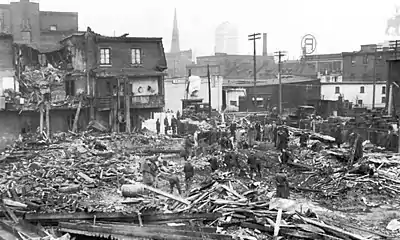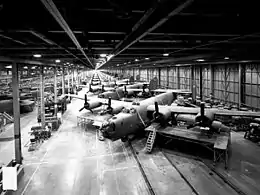1944 Montreal RAF Liberator VI crash
On April 25, 1944, a Royal Air Force Liberator B Mark VI en route to Britain via Gander, Newfoundland crashed into the Griffintown neighborhood in downtown Montreal, Quebec minutes after taking off from Dorval Airport. The five-member crew and ten civilians on the ground were killed, and a large fire destroyed at least 10 homes.[1]

Aircraft

Between 1941 and 1945, Montreal's Dorval airport was where 9,000 aircraft were gathered from manufacturers all over North America prior to being transferred by RAF Ferry Command overseas. This Liberator B Mark VI, designated EW-148, had come from its factory in Michigan.[2]
Crash
Just after takeoff at 10:24 AM, the crew reported problems.[3] The plane cleared Mount Royal but started to lose altitude over downtown Montreal. It passed in front of the Sun Life Building and narrowly missed the tower of Windsor Station and the chimney of the Dow Brewery. At 10:30, it struck residential buildings near the corner of Shannon Street and Ottawa Street. There was an explosion, and fire immediately broke out, spread by the 9,000 litres of fuel. Firefighters took hours to contain the blaze.[1] In all, 10 to 15 homes were destroyed in the crash and subsequent fire.[3]
Victims
The flight crew all perished in the crash:
- Pilot Flight Lieutenant Kazimierz Burzynski, 41, was a Polish Air Force veteran of both World Wars, and was a flying instructor.
- Navigator Flight Lieutenant Adolf-Jan Nowicki, 31, had been the PAF for five years and was a veteran of 40 bombing missions over Germany.
- Officer-Pilot Andrej Kuzniacki, 31, had been flying in the Polish Air Force since 1936, but had recently joined Ferry Command.
- Flight Engineer Sergeant Islwyn Jones, 23, born in Swansea, Wales, had served in the Royal Air Force since 1942, and was a veteran of Ferry Command.
- Radio Operator Officer-Pilot James Smith-Wilson, 21, born in Glasgow, Scotland, living in Trenton, N.J., had served in the Royal Canadian Air Force since 1942. This was his first trans-Atlantic flight.
Ten civilians on the ground were killed.
Cause of the crash
The Ministry of Defense report cited structural failure of the tail section as the cause of the crash. Witnesses in the Sun Life Building described seeing part of the tail detached as it flew at low altitude apparently trying to reach the river to ditch.[3]
References
- "Le pire accident d'avion jamais survenu à Montréal", La Presse, 25 April 1944
- Juno Beach Centre Ferry Aircrafts [sic] Overseas
- Pierre St-Cyr,Griffintown; l'écrasement d'un bombardier le 25 avril 1944, 27 février 2010
External links
- Pierre St-Cyr, Griffintown; l'écrasement d'un bombardier le 25 avril 1944, 27 février 2010, 60 pages